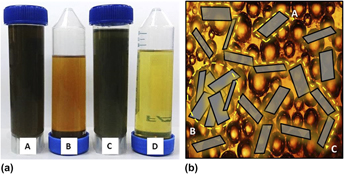Crossref Citations
This article has been cited by the following publications. This list is generated based on data provided by
Crossref.
2016.
Corrigenda.
Journal of Materials Research,
Vol. 31,
Issue. 13,
p.
1983.
Osama, Mohamed
Singh, Amarpreet
Walvekar, Rashmi
Khalid, Mohammad
Gupta, Thummalapalli Chandra Sekhara Manikyam
and
Yin, Wong Wai
2017.
Recent developments and performance review of metal working fluids.
Tribology International,
Vol. 114,
Issue. ,
p.
389.
Kotia, Ankit
Kumar, Ravindra
Haldar, Abhisek
Deval, Piyush
and
Ghosh, Subrata Kumar
2018.
Characterization of Al2O3-SAE 15W40 engine oil nanolubricant and performance evaluation in 4-stroke diesel engine.
Journal of the Brazilian Society of Mechanical Sciences and Engineering,
Vol. 40,
Issue. 1,
Esquivel-Gaon, Margarita
Nguyen, Nhung H. A.
Sgroi, Mauro F.
Pullini, Daniele
Gili, Flavia
Mangherini, Davide
Pruna, Alina Iuliana
Rosicka, Petra
Sevcu, Alena
and
Castagnola, Valentina
2018.
In vitro and environmental toxicity of reduced graphene oxide as an additive in automotive lubricants.
Nanoscale,
Vol. 10,
Issue. 14,
p.
6539.
Wang, Beibei
Fu, Qiangang
Li, Hejun
Qi, Lehua
Song, Qiang
and
Fu, Yewei
2019.
In Situ Growth of Graphene on Carbon Fabrics with Enhanced Mechanical and Thermal Properties for Tribological Applications of Carbon Fabric–Phenolic Composites.
Tribology Transactions,
Vol. 62,
Issue. 5,
p.
850.
Kumar, Parveen
and
Wani, M F
2019.
Effect of temperature on the friction and wear properties of graphene nano-platelets as lubricant additive on Al-25Si alloy.
Materials Research Express,
Vol. 6,
Issue. 4,
p.
046513.
Rashmi, W
Osama, M
Khalid, M
Rasheed, AK
Bhaumik, S
Wong, W. Y
Datta, S
and
TCSM, Gupta
2019.
Tribological performance of nanographite-based metalworking fluid and parametric investigation using artificial neural network.
The International Journal of Advanced Manufacturing Technology,
Vol. 104,
Issue. 1-4,
p.
359.
Rasheed, Abdul Khaliq
Khalid, Mohammad
Mohd Nor, Ariff Farhan Bin
Wong, Wai Yin
Duolikun, Tuerxun
Natu, Varun
Barsoum, Michel. W.
Leo, Bey Fen
Zaharin, Haizum Aimi
and
Ghazali, Mariyam Jameelah
2020.
MXene-graphene hybrid nanoflakes as friction modifiers for outboard engine oil.
IOP Conference Series: Materials Science and Engineering,
Vol. 834,
Issue. 1,
p.
012039.
Ali, Mohamed Kamal Ahmed
and
Xianjun, Hou
2020.
Improving the heat transfer capability and thermal stability of vehicle engine oils using Al2O3/TiO2 nanomaterials.
Powder Technology,
Vol. 363,
Issue. ,
p.
48.
Elagouz, Ahmed
Ali, Mohamed Kamal Ahmed
Xianjun, Hou
and
Abdelkareem, Mohamed A A
2021.
Thermophysical and tribological behaviors of multiwalled carbon nanotubes used as nanolubricant additives.
Surface Topography: Metrology and Properties,
Vol. 9,
Issue. 4,
p.
045002.
Ghosh, Gaurab Kumar
Kotia, Ankit
Kumar, Niranjan
and
Ghosh, Subrata Kumar
2021.
Advances in Metrology and Measurement of Engineering Surfaces.
p.
109.
Ta, Thi D.
Kiet Tieu, A.
and
Tran, Bach H.
2022.
Influences of iron and iron oxides on ultra-thin carbon-based tribofilm lubrication.
Tribology International,
Vol. 173,
Issue. ,
p.
107665.
Sadiq, Ibrahim Ogu
Suhaimi, Mohd Azlan
Sharif, Safian
Mohd Yusof, Noordin
and
Hisam, Muhammad Juzaili
2022.
Enhanced performance of bio-lubricant properties with nano-additives for sustainable lubrication.
Industrial Lubrication and Tribology,
Vol. 74,
Issue. 9,
p.
995.
Suresh, K.
Selvakumar, P.
Kumaresan, G.
Vijayakumar, M.
Ravikumar, M.
and
Jenita, N. Rachael
2023.
A critical review on the effect of morphology, stability, and thermophysical properties of graphene nanoparticles in nanolubricants and nanofluids.
Journal of Thermal Analysis and Calorimetry,
Vol. 148,
Issue. 2,
p.
451.
Ranju, M.R.
Abhilash, P.M.
and
Kesavan, D.
2024.
Rolling contact fatigue studies on AISI 4140 steel under formulated lubrication conditions with nano graphene additives.
Wear,
Vol. 544-545,
Issue. ,
p.
205311.
Lai, Ching-Ming
How, Heoy Geok
Jason, Yeoh Jun Jie
Teoh, Yew Heng
Yaqoob, Haseeb
Zhang, Shengfu
Rafe Hatshan, Mohammad
and
Sher, Farooq
2024.
Tribological characterisation of graphene hybrid nanolubricants in biofuel engines.
Fuel,
Vol. 357,
Issue. ,
p.
129654.





